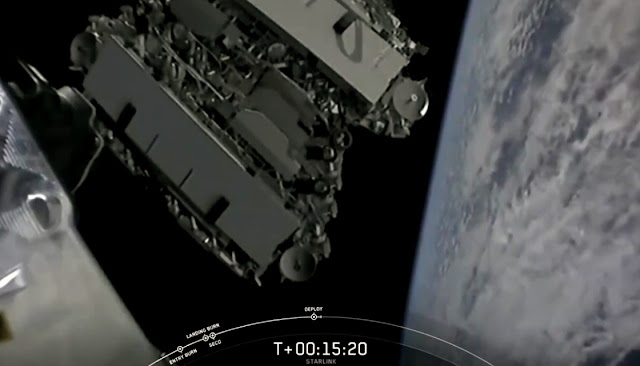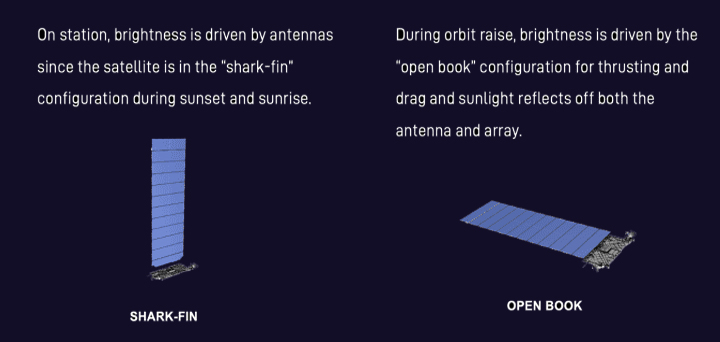 |
| Starlink Satelite Image |
Elon Musk's SpaceX expects to lose almost the entire launch's worth of Starlink satellites after a solar storm struck the Earth's atmosphere.
Because of unfavorable scheduling, up to 40 of SpaceX's Starlink satellites could fall out of orbit: The satellites were launched into a solar storm by the company.
On February 3, SpaceX launched a batch of 49 Starlink internet satellites, and the company now expects to lose the majority of them due to a space weather event known as a geomagnetic storm. This happens when charged particles from the sun, known as solar winds, collide with the Earth's magnetic field. The charged particles can cause the upper atmosphere to thicken by heating it up. (Yes, there is still weather in the most distant parts of space. Thousands of kilometers away, the Earth's atmosphere fades away.)
The satellites launched by SpaceX last week were expected to join roughly 2,000 Starlink satellites already in orbit as the company works to rapidly keep increasing its global space-based internet business — a first-of-its-kind venture that aims to provide high-speed internet access to people in even the most remote parts of the world. In order to provide high-speed, continuous coverage, SpaceX has stated that it will eventually require as many as 42,000 satellites, all working in tandem to blanket the planet in connectivity. Currently, SpaceX has roughly 1,900 Starlink satellites in orbit, with nearly 145,000 users.
Given that space weather monitoring already knew the storm was coming, it's unclear why SpaceX decided to go forward with the launch on February 3. Space weather has previously caused rocket launches to be postponed. Because of a massive solar flare, Orbital Sciences had to postpone a launch in 2014.
It's unclear how much money will be lost. SpaceX has not disclosed how much it costs to create a Starlink satellite, while the company's president, Gwynne Shotwell, stated in 2019 that the price was well below $1 million per piece.
According to SpaceX, "the escalation speed and intensity of the storm caused atmospheric drag to surge" by up to 50% more than the satellites normally experience in low orbit. When the increased air drag was noticed, the company's operations team moved the satellites into a fail-safe mode that spins the spacecraft onto its edge to reduce drag — a posture known as a "shark-fin" orientation.
According to Bill Murtagh, program coordinator at the National Oceanic and Atmospheric Administration's Space Weather Prediction Center, "different companies have their own criteria" for determining whether or not a space weather event will disrupt their launch.
However, GPS data from the Starlink satellites "suggests that the escalation speed and severity of the storm caused air drag to climb up to 50% higher than during previous launches," SpaceX noted in a website update. According to the business, "the Starlink team directed the satellites into a safe-mode where they would fly edge-on (like a sheet of paper) to avoid drag—effectively 'taking refuge from the storm.'"
However, basic data indicates that the increased drag from the storm prevented the satellites from exiting safe mode, and "up to 40 of the satellites will reenter or have already reentered the Earth's atmosphere," according to SpaceX post.
The failed satellites should not endanger other satellites throughout their descent, and they should disintegrate as they hit the thickest region of the Earth's atmosphere, posing no harm to people or property on the ground.
According to the company, all of the safety safeguards are in place by design. SpaceX has stated that it launches its Starlink satellites at a lower altitude than their intended orbit in order to ensure that if a satellite malfunctions, it is not left to cruise uncontrollably across space for an extended period of time – a critical space debris mitigation effort.
However, the fact that these Starlink satellites were deployed at a lower altitude could explain why they were so adversely affected by the geomagnetic storm.
NASA expressed worries in a new filing with the Federal Communications Commission, which must approve satellite launches, that SpaceX's anticipated number of satellites could pose a threat to the International Space Station and other critical assets in space.
 |
| SpaceX |
What Does SpaceX's Loss Mean?
SpaceX does not publish the actual cost of its Starlink satellites or Falcon 9 launches because it is a private firm, but losing the majority of the mission might cost upwards of $50 million.
When SpaceX reuses its Falcon 9 rockets, the cost of each launch is around $28 million to $30 million, according to the firm. Furthermore, the company's leadership has stated that a cost estimate of $1 million per satellite is "far off." At half that figure ($500,000 per satellite), the loss of around 40 satellites would cost around $20 million.
In the past, astronomer Jonathan McDowell said, SpaceX has deorbited "one or two" Starlink satellites following a mission. McDowell is a satellite launch cataloguer at the Harvard-Smithsonian Center for Astrophysics.
"However, losing the majority of the batch is exceptional," McDowell said. "This is huge in comparison to anything that has come before."
McDowell also stated that the loss is significant for SpaceX because the firm has "been quite successful" in the "context of historic satellite launches."
"At least the rocket is fairly reliable and there have been relatively few total failures of Starlink satellites since mid-2020," McDowell said.
It's all about the climatic factors in outer space.
The sun completes a solar cycle of calm and stormy activity every decade or so, and a new one begins.
Solar flares and coronal mass ejection events, which occur when the sun's outer atmosphere ejects plasma and magnetic fields, can disrupt the power system, satellites, GPS, airplanes, rockets, and astronauts in space. By influencing radio frequencies, space weather has been known to interrupt earthly communications networks.
Solar Cycle 25 started in December of this year. We're coming out of a period of relative calm, and the current cycle is predicted to reach its most active phase of space weather in 2025.
The geomagnetic storm that hit the Starlink satellites last week was a two on a scale of one to five, according to Murtagh, which is a rather mild storm. Every 11-year solar cycle, the sun unleashes "several hundred" of these storms, according to Murtagh.
"The northern lights, which everyone adores, are a wonderful visible manifestation of space weather. However, as we learned on Friday, the ramifications of some of these technologies can be extremely serious "Murtagh expressed his thoughts.









0 Comments
please do not enter any spam link in the comment box